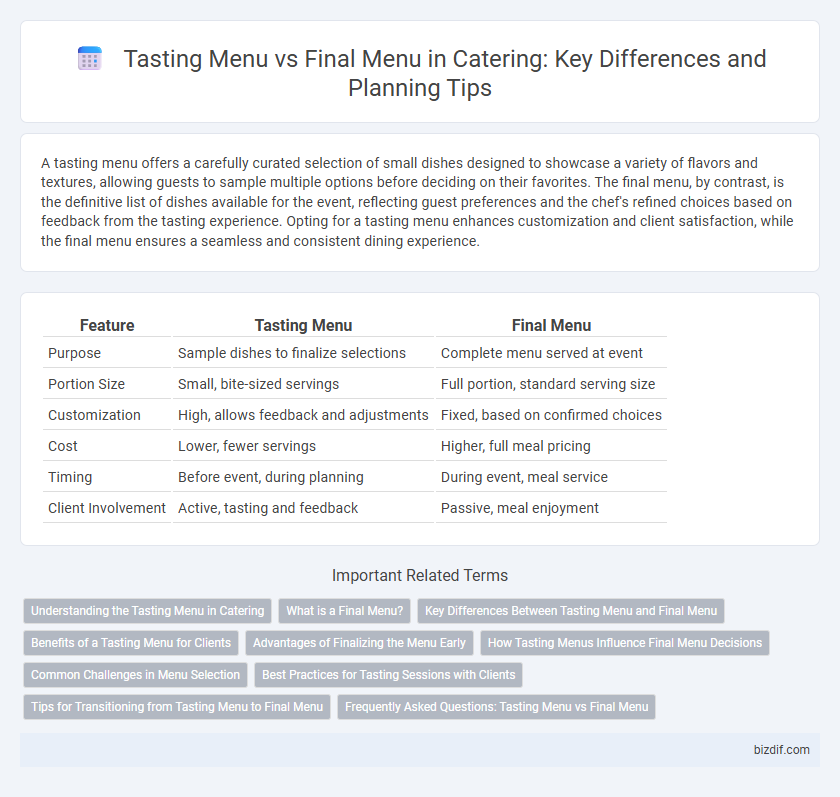A tasting menu offers a carefully curated selection of small dishes designed to showcase a variety of flavors and textures, allowing guests to sample multiple options before deciding on their favorites. The final menu, by contrast, is the definitive list of dishes available for the event, reflecting guest preferences and the chef's refined choices based on feedback from the tasting experience. Opting for a tasting menu enhances customization and client satisfaction, while the final menu ensures a seamless and consistent dining experience.
Table of Comparison
| Feature | Tasting Menu | Final Menu |
|---|---|---|
| Purpose | Sample dishes to finalize selections | Complete menu served at event |
| Portion Size | Small, bite-sized servings | Full portion, standard serving size |
| Customization | High, allows feedback and adjustments | Fixed, based on confirmed choices |
| Cost | Lower, fewer servings | Higher, full meal pricing |
| Timing | Before event, during planning | During event, meal service |
| Client Involvement | Active, tasting and feedback | Passive, meal enjoyment |
Understanding the Tasting Menu in Catering
A tasting menu in catering serves as a curated preview of the final menu, allowing clients to sample and evaluate dishes before making a decision. It helps caterers adjust flavors, presentation, and portion sizes according to client preferences and event requirements. This process ensures the final menu aligns perfectly with the event's theme, dietary restrictions, and guest expectations, enhancing overall satisfaction.
What is a Final Menu?
A final menu in catering is the definitive selection of dishes approved for serving at an event, based on client preferences, dietary requirements, and seasonal availability. It reflects carefully curated options from the tasting menu after feedback and adjustments, ensuring consistency in quality and presentation. The final menu also maximizes ingredient efficiency and aligns with budget constraints, providing a seamless dining experience.
Key Differences Between Tasting Menu and Final Menu
Tasting menus offer a curated selection of small, experimental dishes designed to showcase a chef's creativity and allow guests to sample a variety of flavors. Final menus represent the definitive list of dishes available for the event, reflecting adjustments based on seasonal ingredients, guest preferences, and logistical considerations. The key difference lies in the tasting menu's role as a preliminary concept versus the final menu's function as the confirmed offering for the catering service.
Benefits of a Tasting Menu for Clients
A tasting menu allows clients to experience a variety of flavors and dishes in smaller portions, providing a comprehensive preview of the final menu. This approach helps clients make informed decisions about their preferences and ensures satisfaction with the culinary direction. By offering a diverse array of options, tasting menus enhance client confidence and reduce the risk of menu dissatisfaction at the event.
Advantages of Finalizing the Menu Early
Finalizing the menu early in catering ensures precise ingredient sourcing, reducing costs and minimizing food waste. Early menu decisions facilitate efficient kitchen workflow and staff training, enhancing service quality during the event. Confirmed menus also provide clients with clear expectations, improving overall satisfaction and allowing smooth coordination with dietary restrictions and preferences.
How Tasting Menus Influence Final Menu Decisions
Tasting menus provide critical insights into flavor combinations, portion sizes, and ingredient quality, allowing chefs to refine the final menu based on guest preferences and feedback. They serve as a practical experiment to balance creativity with practicality, ensuring dishes meet taste expectations and operational feasibility. Data gathered from tasting sessions directly influences menu item selection, presentation, and pricing strategies in catering events.
Common Challenges in Menu Selection
Selecting a tasting menu often presents challenges such as limited sample size and difficulty in accurately predicting guest preferences, whereas final menus require careful portion control and ingredient consistency to ensure quality across all servings. Both stages face constraints related to dietary restrictions, seasonal ingredient availability, and budget management, which impact menu feasibility and guest satisfaction. Balancing creative dish variety with operational efficiency remains a common hurdle in transitioning from tasting to final menu execution.
Best Practices for Tasting Sessions with Clients
During tasting sessions, presenting a curated tasting menu rather than the full final menu helps clients focus on flavor profiles and ingredient quality without feeling overwhelmed. Offering a diverse selection that highlights signature dishes ensures clients experience the caterer's culinary style and attention to detail. Documenting client feedback and preferences during tastings allows for precise adjustments in the final menu, improving satisfaction and event success.
Tips for Transitioning from Tasting Menu to Final Menu
Carefully analyze guest feedback from the tasting menu to identify popular dishes and flavor profiles that resonate well, ensuring the final menu aligns with client preferences and event themes. Prioritize ingredient availability, seasonal variations, and portion sizes to maintain consistency and cost-efficiency when scaling from tasting samples to full-service dishes. Collaborate closely with chefs and service staff to refine presentation, timing, and staff training, guaranteeing a seamless dining experience from tasting to event execution.
Frequently Asked Questions: Tasting Menu vs Final Menu
A tasting menu serves as a curated preview of select dishes allowing clients to experience the chef's style and flavor combinations before finalizing their event menu. The final menu reflects the complete selection and portion sizes tailored specifically to guests' preferences and dietary requirements, ensuring a seamless dining experience. Common questions often address menu customization flexibility, portion adjustments between tasting and final service, and how seasonal ingredient availability may influence the final offerings.
Tasting menu vs Final menu Infographic

 bizdif.com
bizdif.com